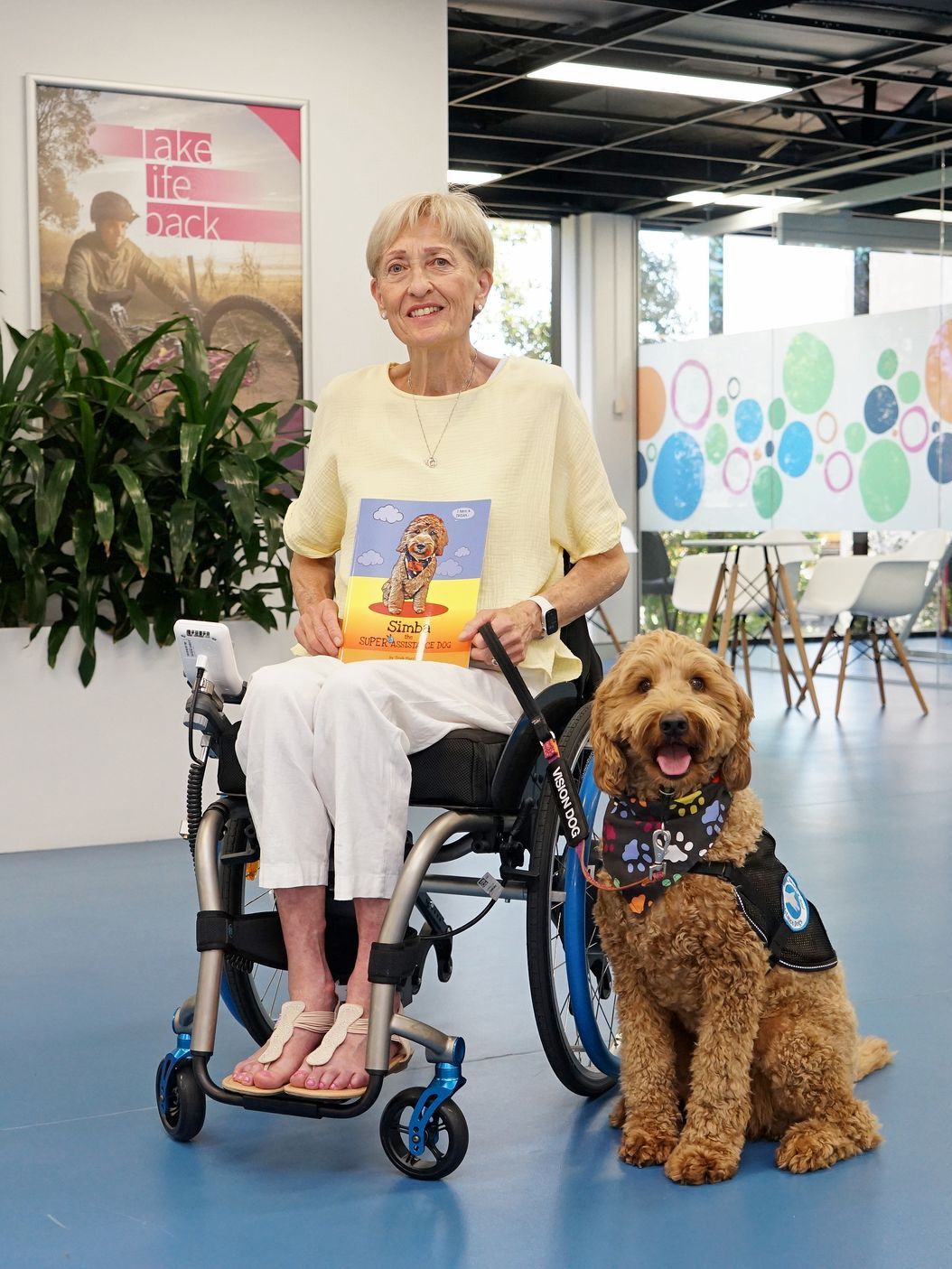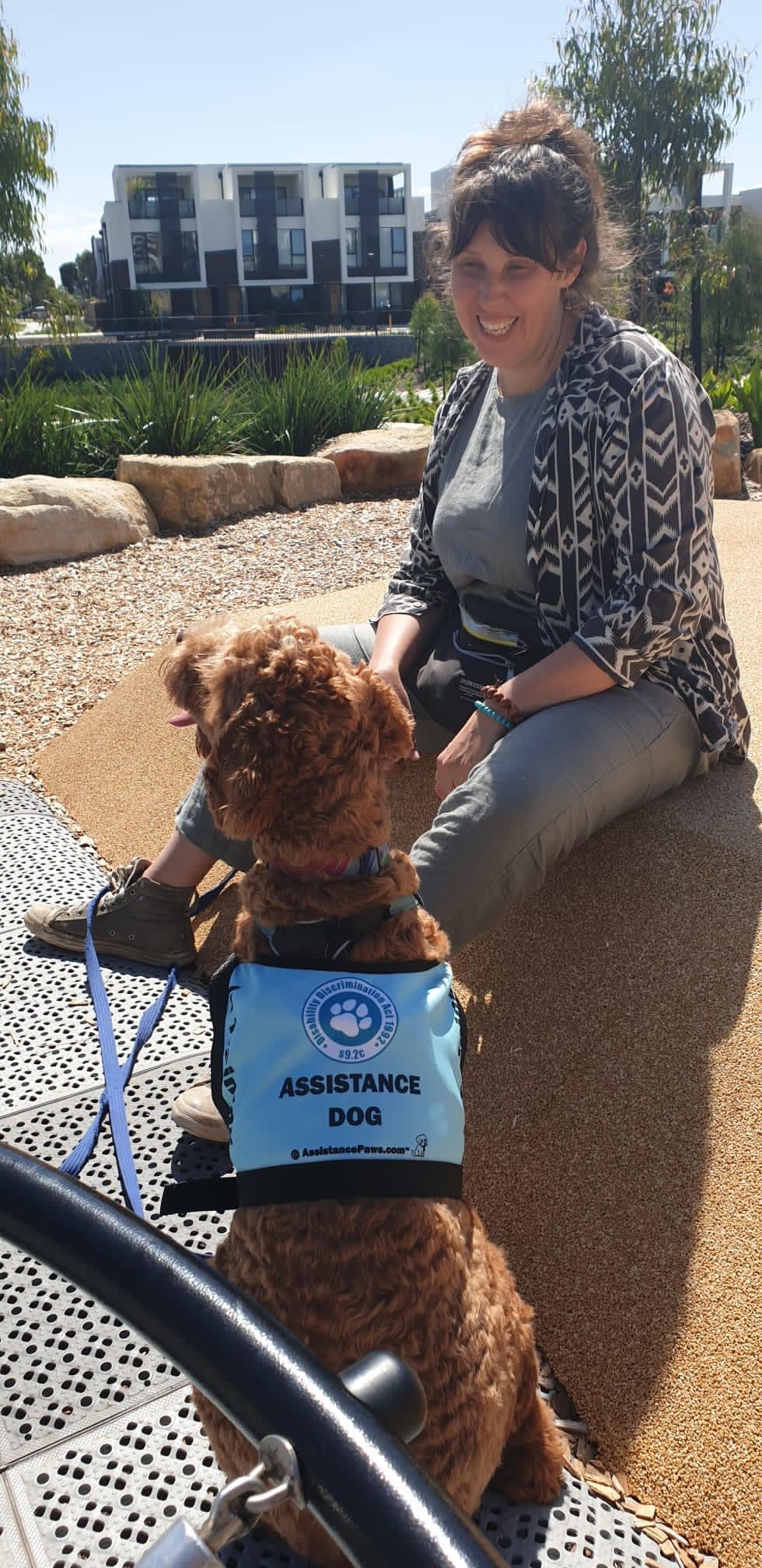Support Dogs
Assistance Dog & Therapy Dog
Difference between Assistance Dogs & Therapy Dogs
Support Dogs is a catch-all description for both Assistance and Therapy Dogs.
Assistance dogs are trained to assist an individual with specific emotional and/or physical disabilities.
A therapy dog is is trained to provide affection, comfort and support to people in a group or public setting.
Learn more about
Assistance Dogs or
Therapy Dogs.

“It is amazing how much love and laughter they bring into our lives and even how much closer we become with each other because of them.”
Assistance Dog
Do Australian Labradoodles make good Assistance Dogs?
The answer to this is YES! although not every puppy in the litter is chosen. Australian Labradoodles are smart, intuitive and willing to please and given the right environment and training, they make wonderful Assistance Dogs. They are also low shedding which means they are perfect for people who have allergies. At Misty Mountain Labradoodles we have an extensive stimulation and training program for our puppies which starts at 3 days old. We have procedures and protocols to help us to determine which puppy/puppies in the litter may be up for the very important job of assistance work
How can an Assistance Dog help me?
Some of the tasks undertaken by an Assistance Dog include but are not limited to:
- pulling a wheelchair
- helping people to balance if they have walking difficulties
- turning on light switches
- moving the arms or legs of people who are paralysed
- opening and closing doors, drawers and fridges
- assisting with making beds
- retrieving or picking up items like mobile phones or keys
- pushing pedestrian crossing buttons
- picking up clothing and helping take washing from a machine
- paying cashiers
- barking to alert their owners to danger
- alerting people to seizures (sometimes before they occur) or other medical issues, such as low blood sugar in a diabetic child or adult.
- finding and leading another person to the owner or affected child
How much training do assistance dogs need?
Once a puppy has been selected from the litter as being suitable for assistance work, the puppy starts the training straight away. Basic obedience is taught to the puppy until it is around 6-12 months old which is the time when the training starts which is targeted specifically to the clients needs. At Misty Mountain Labradoodles we work with trainers who can take the handler and the puppy through the basic obedience required and get the puppy to a standard that is ready for it to learn the specific skills required for its recipient.
We also work with a Queensland Government approved trainer who can help to train the puppy and take it through its Public Access Test (PAT) and issue a working jacket and identification card which allows the dog into public places. Generally it takes up to two years for a dog to become fully certified - but at Misty Mountain Labradoodles we have seen our dogs pass the PAT test in just over 13 months.
Do I need to do all of the training?
If the recipient is unable to raise the puppy through its puppy stage and work with the trainer to get the puppy through to its basic obedience training, then Misty Mountain Labradoodles can arrange for a puppy raisers to take the puppy for the first 6-12 months and get it to the standard where it is ready to learn the specific skills required for the recipient.
Its important to note that the training never stops throughout the dogs life! You will be required to continually shape and train your dog and the dog will also be required to be assessed every two years by a Government Approved Trainer.
What is the cost of an Assistance Dog?
The cost for an Assistance Dog includes the cost of the puppy plus the basic obedience training, payment to the puppy raisers (if we arrange a puppy raiser to raise the puppy), costs for the approved Government trainer, certification, vet fees, food, medications and pet insurance. This is quite an investment and you need to be prepared or investigate support such as NDIS - we have had examples of Misty Mountain pups and associated costs being covered through NDIS funding support. If you would like more details on costs, please
get in touch.
What is the first step in applying for an Assistance Dog through Misty Mountain Labradoodles?
The first step is to complete the application form here Assistance Dog Expression of Interest.
Misty Mountain Labradoodles will then make contact with you to discuss your needs and talk through the various options of raising the puppy, training the puppy and certification.
If you are successful with your application then a $500 deposit is required to secure you a puppy from the next available litter. Please be aware that not all puppies are suitable so you may have to wait for the right pup to come along.

Children's Book
Simba the Super Assistance Dog
Simba the Super Assistance Dog is a fun children's book based on a real life Misty Mountain Labradoodle puppy and his journey into becoming an Assistance Dog.
Therapy Dog
A therapy dog is a dog that is trained to provide affection, comfort and support to people, often in settings such as hospitals, retirement homes, nursing homes, schools, libraries, hospices, or disaster areas.
Therapy dogs play a vital role in promoting emotional well-being and providing comfort to those in need. Their gentle presence has been shown to lower stress levels, reduce anxiety, and increase feelings of happiness and security. Therapy dogs also help to facilitate social interactions and improve overall mental health.
We love placing Misty Mountain Labradoodles pups as therapy dogs! Over the years we have seen our puppies become therapy dogs in a wide range of situations including reading dogs in schools, supporting in a psychologist rooms, classroom support, nursing homes, singing lessons (!) and supporting NDIS support workers.
We cant wait to see where else Misty Mountain Australian Labradoodles will work their therapy magic! If you would like to chat about this, please get in touch.
"The only thing better than a dog is a puppy."
Frequently Asked Questions
What is the difference between an assistance dog, a therapy dog?

Support Dogs is a catch-all description for both Assistance and Therapy Dogs.
Assistance dogs are trained to assist an individual with specific emotional and/or physical disabilities.
A therapy dog is is trained to provide affection, comfort and support to people in a group or public setting.
How do I qualify for an Assistance Dog?
To qualify for an Assistance Dog from Misty Mountain Labradoodles you need to have a referral from a doctor or other professional. You would then need to complete the Application form and chat with a representative from Misty Mountain Labradoodles.
What Tasks does an Assistance Dog perform?
Some of the tasks undertaken by an Assistance Dog include but are not limited to:
- pulling a wheelchair
- helping people to balance if they have walking difficulties
- turning on light switches
- moving the arms or legs of people who are paralysed
- opening and closing doors, drawers and fridges
- assisting with making beds
- retrieving or picking up items like mobile phones or keys
- pushing pedestrian crossing buttons
- picking up clothing and helping take washing from a machine
- paying cashiers
- barking to alert their owners to danger
- alerting people to seizures (sometimes before they occur) or other medical issues, such as low blood sugar in a diabetic child or adult.
- finding and leading another person to the owner or affected child
How do I certify my dog as an assistance dog?
Certifying a dog as an assistance dog in Australia involves several steps to ensure they meet the required standards and can legally accompany their handler in public places. Here's an overview of the process:
1. Qualification as an Assistance Dog:
- In Australia, assistance dogs are defined as trained to perform specific tasks that assist a person with a disability to alleviate the effect of their disability. This could include guide dogs for the blind, hearing dogs for the deaf, and service dogs for people with mobility impairments or medical conditions.
2. Training and Assessment:
- Your dog must undergo appropriate training to perform tasks that assist with your disability. The training should be conducted by a reputable organisation or trainer who specialises in assistance dog training and who is registered with GHAD.
3. Assessment of Suitability:
- After training, your dog will need to undergo an assessment to ensure they meet the behavioral and obedience standards required for assistance dogs. This assessment may include obedience testing, public access testing, and verification of task training.
4. Certification and Registration:
- There is no national certification or registration process for assistance dogs in Australia. However, you may need to obtain documentation from the organisation or trainer that certified your dog as an assistance dog. This documentation may include a letter or certificate stating that your dog meets the required standards.
5. Access Rights:
- Under the Disability Discrimination Act 1992 (DDA) and relevant state or territory legislation, assistance dogs have legal access rights to public places, including shops, restaurants, public transport, and accommodation. These rights are contingent upon the dog's behavior and the handler's ability to control the dog in public settings.
6. Identification:
- While not legally required, some handlers choose to have their assistance dogs wear a specific vest, harness, or identification card to indicate their role as an assistance dog.
7. Educational Awareness:
- It may be beneficial to educate businesses and the public about the rights and responsibilities associated with assistance dogs to ensure smooth access and acceptance in public places.
8. State and Territory Variations:
- Note that specific requirements and processes for certifying assistance dogs may vary slightly between states and territories in Australia. It's advisable to check with your local disability services or relevant authority for any additional guidelines or requirements specific to your area.
By following these steps and ensuring your dog meets the necessary training and behavioral standards, you can certify your dog as an assistance dog in Australia, allowing them to accompany you in public places to assist with your disability.
What rights do I have as a support dog?
Under the Disability Discrimination Act 1992 (DDA) and relevant state or territory legislation, assistance dogs have legal access rights to public places, including shops, restaurants, public transport, and accommodation. These rights are contingent upon the dog's behavior and the handler's ability to control the dog in public settings.




